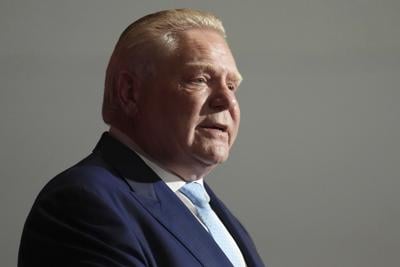Battered by U.S. President Donald Trump’s tariffs, Ontario’s struggling auto, steel and aluminum companies are receiving $1 billion in support loans from Premier Doug Ford.
Finance Minister Peter Bethlenfalvy said Wednesday that funds from the first phase of the province’s $5 billion “Protect Ontario Account” would soon flow to eligible employers.
“We know businesses are facing tremendous uncertainty and we will continue to protect Ontario’s workers, businesses and jobs from the impacts of U.S. tariffs while building on a more resilient and self-reliant economy to secure long-term prosperity,” Bethlenfalvy told reporters at Queen’s Park.
First announced in his May 15 budget, the program gives up to $1 billion in emergency loans and complements similar aid from Prime Minister Mark Carney’s federal government.
“This program is specifically designed to address businesses impacted by (U.S.) only after they’ve exhausted all federal tariff support partners,” he said.
Bethlenfalvy said he hoped the money would ease the burden for payroll, leases and utilities payments during the trade standoff with Trump.
As well, it could prevent businesses from laying off workers or even closing their doors while ensuring “critical supply chains” are preserved.
Speaking on Tuesday in Windsor, Canada’s hard-hit automotive capital, Ford signalled relief was coming.
“We’re going to start with $1 billion tomorrow and then just keep adding. We’re going to focus on helping small businesses. We’re going to really focus on the auto sector and the steel sector. They’re the ones that are really getting hit the hardest,” the premier said.
“So we’re rolling out the money and I won’t hesitate to keep rolling it out, because I know we’re going to get through this, and we’re going to come out stronger than ever before.”
Business can determine if they are eligible for the provincial loans, which must be repaid within six years, on a .
Initially, the program is open to companies operating in Ontario with a minimum of 10 employees and $2 million in annual revenues and have at least three years of operations and financial statements. Start-ups are ineligible as are non-profits and firms that want to use the funds to buy property or new equipment.
Loans will range anywhere from $250,000 to $40 million, said Bethlenfalvy, emphasizing there are measures in place to ensure only qualified recipients get taxpayers’ dollars.
“We’re confident we learned a lot of things in COVID,” he said, referring to the pandemic Support for Families program that was defrauded to the tune of $10.8 million.
In the coming weeks, the government will hire “a third-party financial agent ... to effectively and efficiently process applications that have passed the initial screening process.”
The province is reserving the right to charge interest up to the prime rate and to make loan repayments principal-free for the first year.
NDP MPP Jessica Bell (University-Rosedale) pointed out the economic situation is dire for many Ontarians.
“With 700,000 people unemployed in Ontario, I don’t believe that a $1 billion emergency loan fund is adequate,” said Bell.
“We are in very serious economic times and we need a credible and strong, resilient plan that’s not just about emergency loans, but it’s also about investment,” she said.
Earlier this month, Trump unilaterally increased levies on Canadian imports that do not fall within the Canada-U.S.-Mexico Agreement (CUSMA) to 35 per cent.Â
That mostly impacts the auto industry while the steel and aluminum sectors are subject to 50 per cent duties.
But about 85 per cent of all Canadian trade stateside falls under CUSMA and therefore has not been affected by Trump’s moves.
South of the border, the president’s tariffs on countries from around the world are starting to hit American consumers.
Last Thursday, the non-partisan Budget Lab at Yale University determined Trump levies are costing the average household $2,400 (U.S.).
Yale found the average overall tariff rate stateside is now 18.6 per cent, the highest since 1933 during the Great Depression.
When former president Joe Biden left office in January, average tariffs in the U.S. were around two per cent.
“The 2025 tariffs disproportionately affect clothing and textiles, with consumers facing 39 per cent higher shoe prices and 37 per cent higher apparel prices in the short run,” the lab said.
“Shoes and apparel prices stay 19 per cent and 18 per cent higher in the long run respectively.”
Yale also warned real gross domestic growth would be reduced by 0.5 percentage points annually this year and next and that Trump tariffs would cause the unemployment rate to rise 0.3 percentage points in 2025 and 0.7 percentage points in 2026.
“Payroll employment is 505,000 lower by the end of 2025.”
Poor job numbers in the U.S. led Trump to fire labour statistics commissioner Erika McEntarfer and install partisan loyalist E.J. Antoni, whose appointment has been denounced across the political spectrum.
Error! Sorry, there was an error processing your request.
There was a problem with the recaptcha. Please try again.
You may unsubscribe at any time. By signing up, you agree to our and . This site is protected by reCAPTCHA and the Google and apply.
Want more of the latest from us? Sign up for more at our newsletter page.



























To join the conversation set a first and last name in your user profile.
Sign in or register for free to join the Conversation